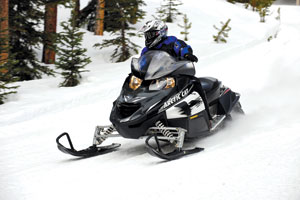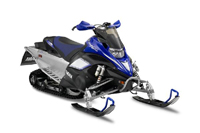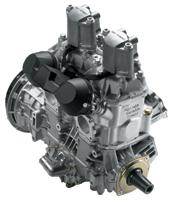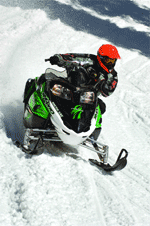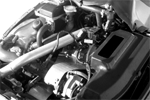The four manufacturers have each assembled an extended-track performance four-stroke snowmobile aimed at riders who want comfort on the trail along with the ability to wick it up: the Arctic Cat Z1 Turbo EXT, Polaris Turbo LX, Ski-Doo Renegade 1200 Adrenaline and Yamaha RS Vector LTX GT. Another cool tidbit is that all four of these machines are new or re-worked – though that’s with glaring generosity to Polaris because all that’s new is its name.
All manufacturers lump these sleds into the “crossover” or “trailversatility” segment, but most riders of these sleds won’t take them off the trail very often. A long track appeals to these buyers for its bump-bridging capability on the trails.
Which sled offers the most comfort? Which machine is the most attractive and has the best carrying capacity for a day or weekend’s worth of cargo? Which one is the best value?
We hit the trail last spring in Grand Lake, Colorado, at our annual Rode Reports testing event to answer these questions and to find out which snowmobile most accurately hits the targeted customer.
Attractive And Comfortable
There’s a reason sleds in this shootout have more sedate graphics and subtle color schemes. Looks and a touch of class are important to comfort-minded performance snowmobilers, and for that reason the Yamaha RS Vector LTX GT leads the class in this category.

Looking at the machine tells you that you’re about saddle up on a luxurious snowmobile. It’s a beautiful sled with great fit and finish and nice color options (red, white or blue). It speaks quality that appeals to this buyer. The version we sampled had coordinated hood and A-arms that pull the package together. Ergonomics and comfort are also important for this rider.
The only bumps we met on this test ride were small, and the Vector LTX rode over them without giving any feedback to the rider. Its tight footwells allow for a good lock-in, but they were too tight for one rider’s preference. The seat profile and density is comfortable, but the same person whose feet felt claustropobic wishes the soft seat was taller because his knees were too high. At a 9.4-gallon capacity, the Yamaha fuel tank holds about a gallon less than the cells on other sleds, but it’s wide at the knees and forces the driver to open up more than on the other three sleds.
All sleds in this grouping have an accessory outlet, but the Vector has an RCA-style plug near the left handgrip to power a heated helmet visor in addition to a standard automotive-style outlet for electronics accessories. In-seat storage is surprisingly spacious, considering the rear-exit exhaust system.

Wind protection is good behind the flared windshield and big cab, and we like the hooked handlebar setup as much as we did when the Deltabox II chassis came out in 2006. The perch is set at a height that allows easy, comfortable steering and the curved bar ends are gentle on palms through turns.
Like the Yamaha, the new Ski-Doo Renegade 1200 Adrenaline is also a leader for its clean finish and parts that fit well with each other. The side panels and hood “clunk” to tell you they’re closed, colors match and parts have a consistent finish with softened edges.
The XR cab is wider than the cold XP body of the two-stroke Ski-Doos, and with windshield flares to deflect cold air around the handlebars, the hands, thighs and mid-section stay warmer. The flip-top rear storage compartment is convenient with enough room for a few pairs of gloves and other supplies, but mileage hounds will want to add an accessory bag for more capacity.

The seat is comfortable and narrow for easy side-to-side transitions, but it’s soft enough to provide the ride-all-day comfort this customer wants. As a bonus, the seat cover has the best grip in this comparison. Behind the seat, a plastic cover on the heat exchanger/tunnel gives the machine a finished look. Ski-Doo takes care of the details.
Some testers put the new Z1 Turbo EXT at the top of the heap for comfort. Ergonomics are excellent. The handlebars and cockpit are very comfortable for all sizes of riders for long rides. If you want to customize it for your tastes, the Infinite Rider Positioning system provides easy handlebar adjustments. The fat handlebar tube keeps the fingers loose on the grips for less fatigue while you try to hang on to all of the sled’s mad horsepower.
Riding the sled feels like you’re sitting low to the ground. Flat footwells keep the ankles relaxed, there’s good running board traction and the seat is wide and comfortable. But all riders thought the cover was too slippery. The sleek windshield offers the least wind protection of the group, but it’s wide and the cab does well to shield the driver from the elements.

The Cat’s styling is maturely sporty. The black suspension rails give the machine a finished look and the hood and windshield’s sharp lines have attitude. (With 177 hp under the hood, a little attitude is expected.) The new green metallic color is cool, but the greens on the seat and plastic parts didn’t match on the prototype we rode. Hopefully Arctic Cat works this out for production. An integrated pouch in the seat is spacious and convenient, though not as roomy as the cavernous plastic trunk on earlier Twin Spars. We’ll take the new zippered design’s better looks, though, and buy an aftermarket bag for long hauls.
The Polaris got mixed reviews in terms of comfort. Some riders found nice overall comfort with a cushy seat and good wind protection from the cab and tall windshield. Others said the cockpit is cramped and confined for space. Rider Select steering provides adjustment, though not as much as the Cat. In addition to in-seat storage, the LX includes a semi-rigid tunnel bag, boosting its carrying capacity beyond the other sleds.

Narrow handlebars contribute to the cramped feeling. One rider usually found his palms were on the outside ends of the bars. The rigid, handlebar-mounted mirrors provide a solid look and feel with clear, vibration-free visibility, but they bump the driver’s helmet if he or she leans in for a corner. You can lean around them, but it’s a distraction that disrupts a rider’s natural range of motion.
Fit and finish isn’t as good as the other sleds, either. The sled felt cheap and dated. The switches and controls debuted on Polaris sleds in 1999, and the gauge is basic. Fortunately it’s easy to read. An obvious corner-cut is the lack of outer bogie wheels on the rear axle. This is OK on a budget IQ Shift model, but these customers expect a finished appearance. They don’t get it with the Turbo LX.
Power To Move You
These four machines are graced with great high-performance four-stroke engines that run smooth and quiet with serious acceleration and top-end speed, but some just do it better than others.

The Z1 Turbo is the most fun engine — by far. This thing rips! And what an acceleration and adrenaline rush it is. Arms stretch and the end of the straightaway comes up quickly when the throttle is pushed to the bar. The 144-inch track this year is a great upgrade over the 128-inch shoe (the only choice in 2009) because it puts more of the power to the ground without roosting as much snow out from the snowflap. While speed and acceleration are good, what if a rider wants to slow down?
The Cat exhibits control, too. The 1056cc Suzuki twin is well mannered as a driver can carry on at slow speeds through windy trails without suffering from a harsh pull on acceleration or a dive from engine braking when you let off the fun flipper.
In a word, the RS Vector LTX’s new 120FI engine is sweet. We’ve always liked the smooth and strong carbureted engine it replaces, but the new fuel-injected version takes those strengths and exploits them. The EFI is livelier and sportier, it pulls harder with smooth acceleration and better response from the thumb. Is it safe to say the 120FI has more of a two-stroke feel than the carb? Riding a carbureted ’09 Vector alongside during this test proved the superiority of the new fuel system.

The fuelie started better, too. We had to open the carb sled’s throttle to help it fire, but the EFI lit up if we so much as breathed on the ignition switch. There is great throttle response and a stout physical reaction when the driver blips the throttle. The powerplant pulls well at low, mid and high speeds, all the way up to about 8500 rpm at wide-open throttle. As always, a rider’s ears are spoiled by the sweet sound from the Yamaha four-stroke exhaust. One downfall is more engine braking than the Cat and Ski-Doo.
The Renegade is the sportiest sled of the group, due equally to its engine and chassis. The Rotax powerplant is an 1170cc triple with fuel injection, rated at 130 hp. In its 2009 inaugural season, the engine suffered from too much engine braking, but engineers recalibrated the system for 2010 to reduce the effects of a driver letting off the throttle.
Most testers thought the engine had a good powerband from its 3400 rpm engagement on up to wide-open throttle with a performance sound from the exhaust. The drivetrain backshifts quickly — like a two-stroke with a stiff spring in the secondary clutch — so it was always ready for a quick pull out of the corners. With noticeably less engine braking, it’s more lively and free-wheeling. It coasts really well and makes the entire ride less tiring. One rider was still disappointed with the engine’s overall performance, though, as it didn’t pull as hard as he expected.

The Turbo LX houses the other turbo-boosted engine in this comparison. The 750 Multi-Purpose Engine (MPE) — made by Weber Motor, a German company — is rated at 150 hp and has been used by Polaris since 2006. It has strong acceleration that pulls especially hard in the mid range; it’s the most fun from about 30 mph and 6000 rpm. The power delivery is relatively smooth, though the wastegate noise sounds like clashing cookie tins that takes some getting used to now that we’re familiar with the Z1 EXT’s smooth and quiet boost.
Some Sleds Handle Better Than Others
The Cat Z1 Turbo EXT and Ski-Doo Renegade are best among these four sleds in terms of handling. A lot of credit goes to the Cat’s new ski that has a stiffer, deeper keel for better bite. The driver can sit back and enjoy the ride as the machine goes where its pointed. There’s no ski lift, drift or pushing through the corners.
One tester said the handling was OK but “quirky.” He had to counter-steer because the 144-inch track wanted to pass the front, he said. Compared to the Yamaha, the EXT’s steering required more effort, but we could trust the green sled to stay on course more than Big Blue.
The Renegade has a 137-inch track and the chassis transfers a lot of weight between the skis and track in and out of turns, which makes it handle well by keeping pressure on the skis when coming into a turn and keeping them planted. The new Pilot 5.7 skis work well with the REV-XR chassis. Weight transfer makes steering effort more noticeable when diving hard into a corner, but in all, effort is surprisingly slight for the weight it carries up front.
The Vector LTX rolls on 136 inches and it feels stable when going straight, but the skis were slow to engage, causing corner push. For comparison, the Yamaha had 3-inch carbides; the Cat had 4 inches. We’re hoping that Yamaha will come up with a new ski, because these boards don’t work well with this chassis, or any chassis for that matter.
One test rider who took a longer shift on the Vector LTX said he really came to appreciate the sled as he piled on the miles. Another tester said handling improves dramatically if the driver leans into the corners. Too much body roll means it isn’t afraid to lift the inside ski a few inches through turns, too, especially when sitting upright on the seat. This makes the sled feel narrow.
The Yamaha handles better than the Polaris, as the 136-inch Turbo LX was a disappointment for handling. Its front end seeks its own route on the trail like its skis are too aggressive. In turns, you wait, wait, wait and then it hooks up and rounds the corner. Steering effort was more than expected.

4 Sleds For 2 Riding Styles
You can’t go wrong with any of the four sleds in this shootout, but some proved to be a better value than others.
The Vector LTX GT ($10,699) most accurately hits its target customer. It’s a fantastic trail sled with a comfortable ride and layout and a superb engine that delivers exhilarating performance. As the lowest priced sled in the shootout, it’s definitely the best value.
Renegade 1200 Adrenaline ($10,849) buyers will get sportier performance than their Vector counterparts. Good weight transfer and decent power contribute, but the REV-XR seat, cab and ergos promote an active riding style. It’s a comfortable machine with suspension calibrations well suited for the intended market.
Arctic’s Z1 Turbo EXT ($13,699) does a good job of meeting its customer’s expectations, but it’s on the performance end of the spectrum like the Renegade. It’s a great snowmobile with industry-leading horesepower, but that isn’t the prime selling point for most of these riders. That power comes at a price — $3,000 more than the Yamaha — hurting the EXT’s value.
Like the Yamaha, the Polaris Turbo LX ($10,799) is better for a cruising rider. All test riders agreed the LX is an average snowmobile, it doesn’t have any standout qualities. Its engine is OK with a high-performance pull, but the sled’s slow handling and cumbersome ergonomics make it the least high-performance among its company here. While its price is competitive with the Vector LTX GT and Renegade 1200, those sleds are a much better value than the Turbo LX.

